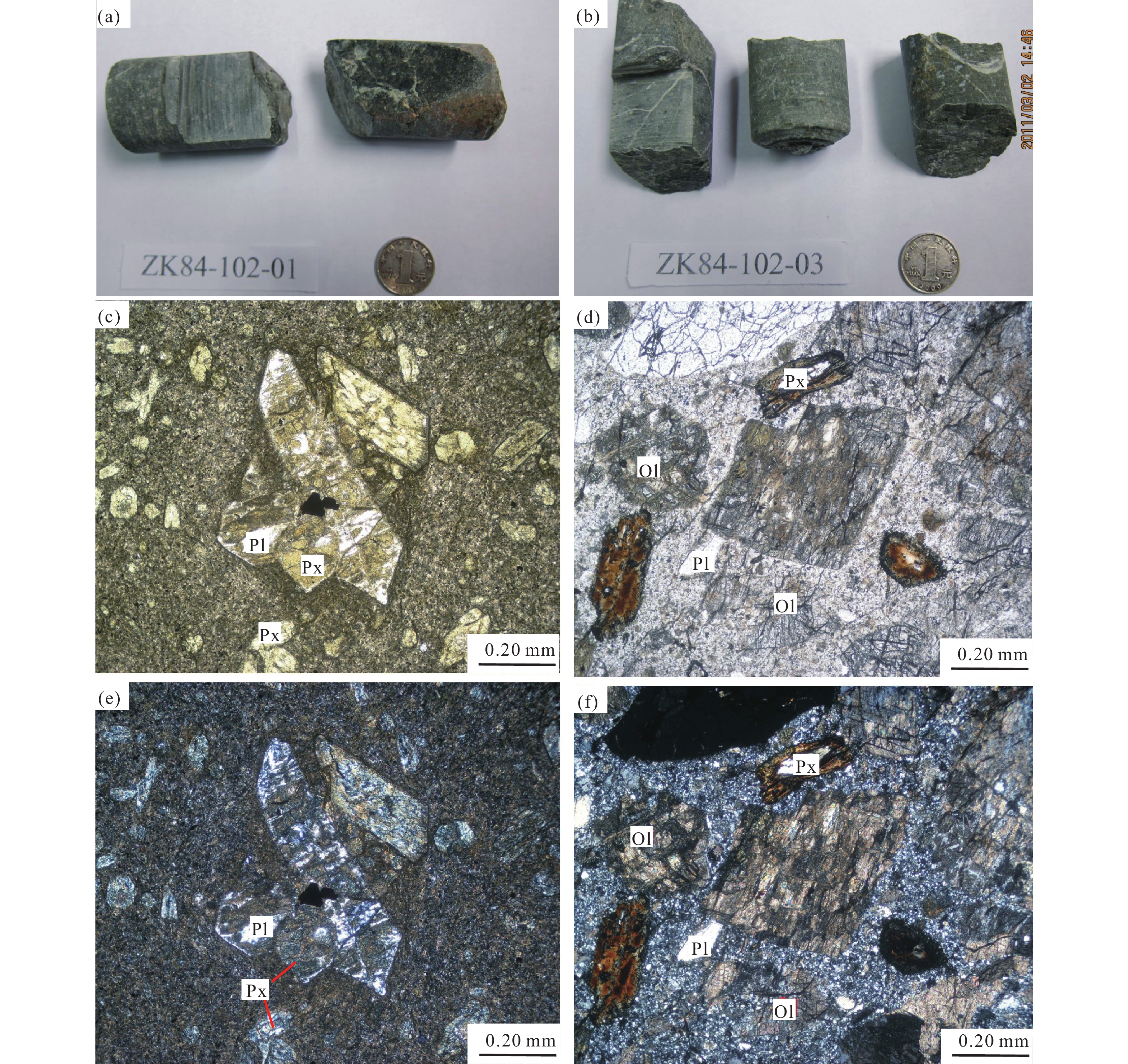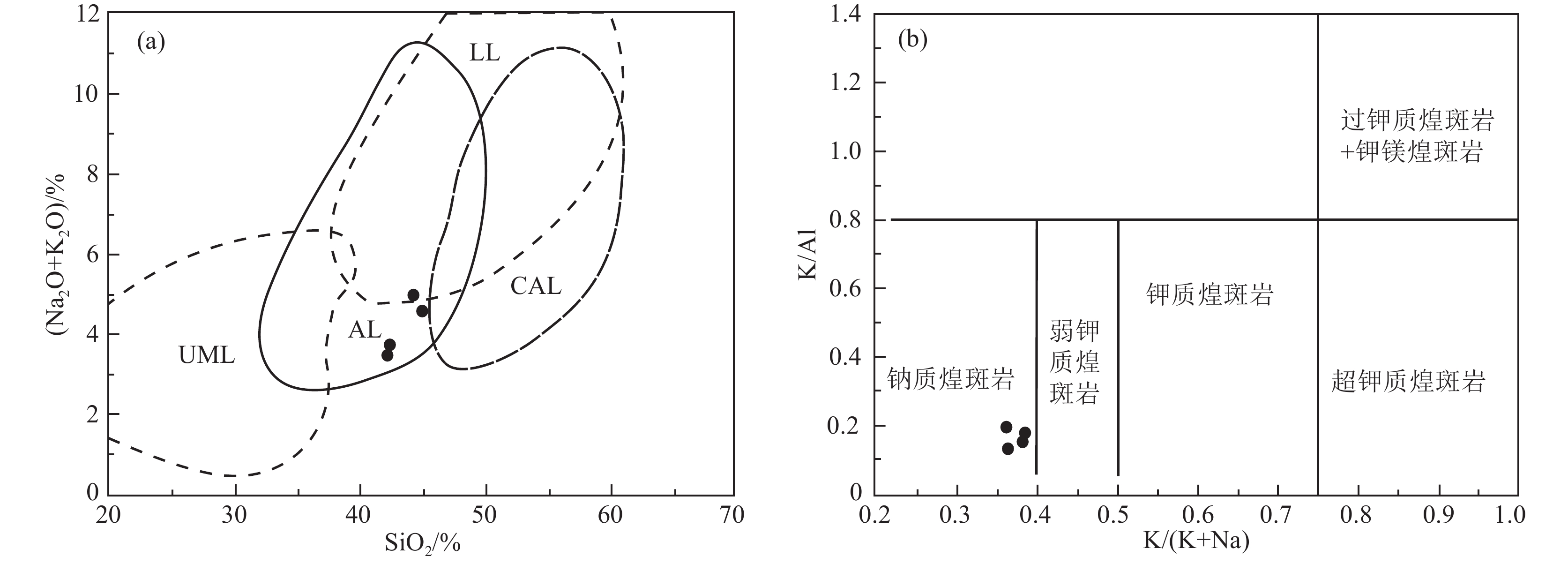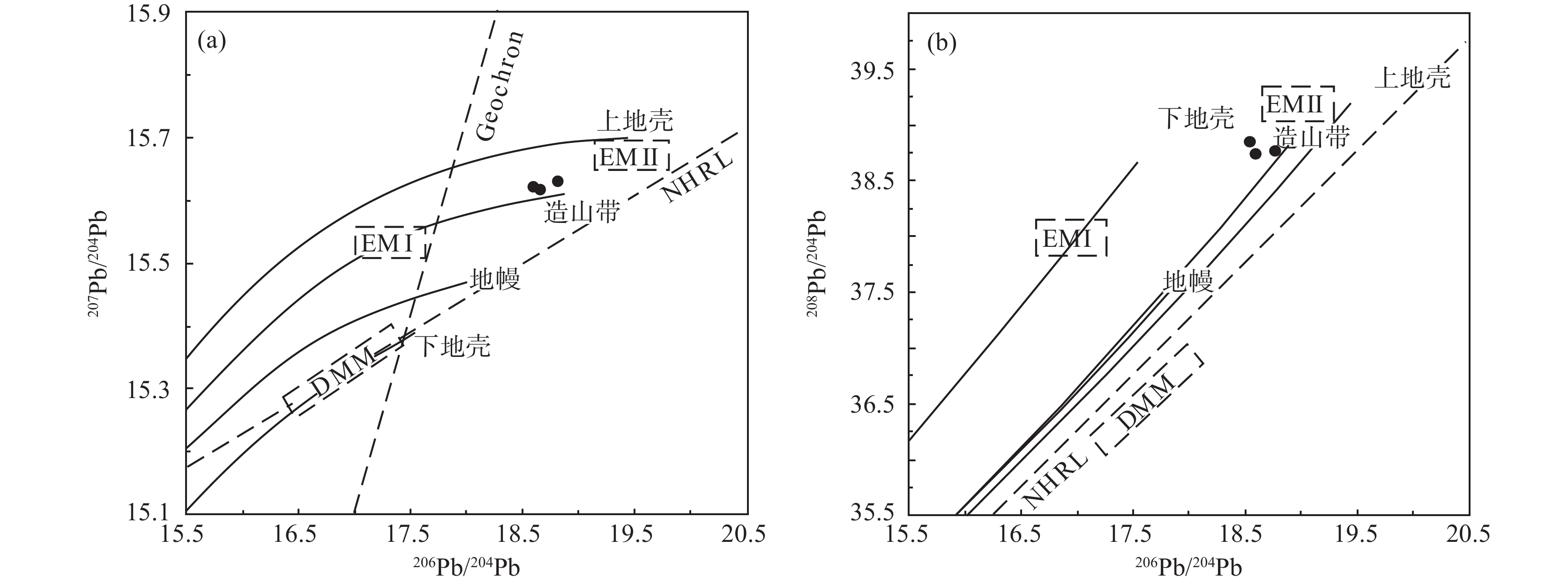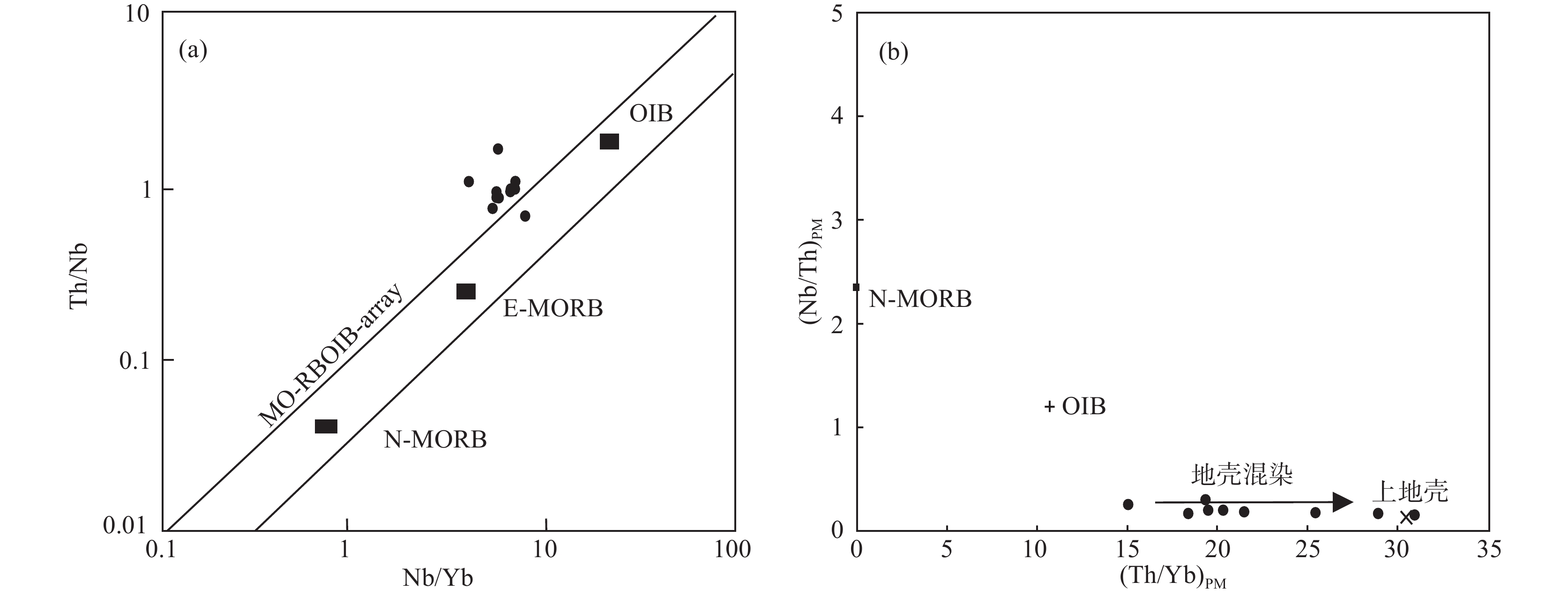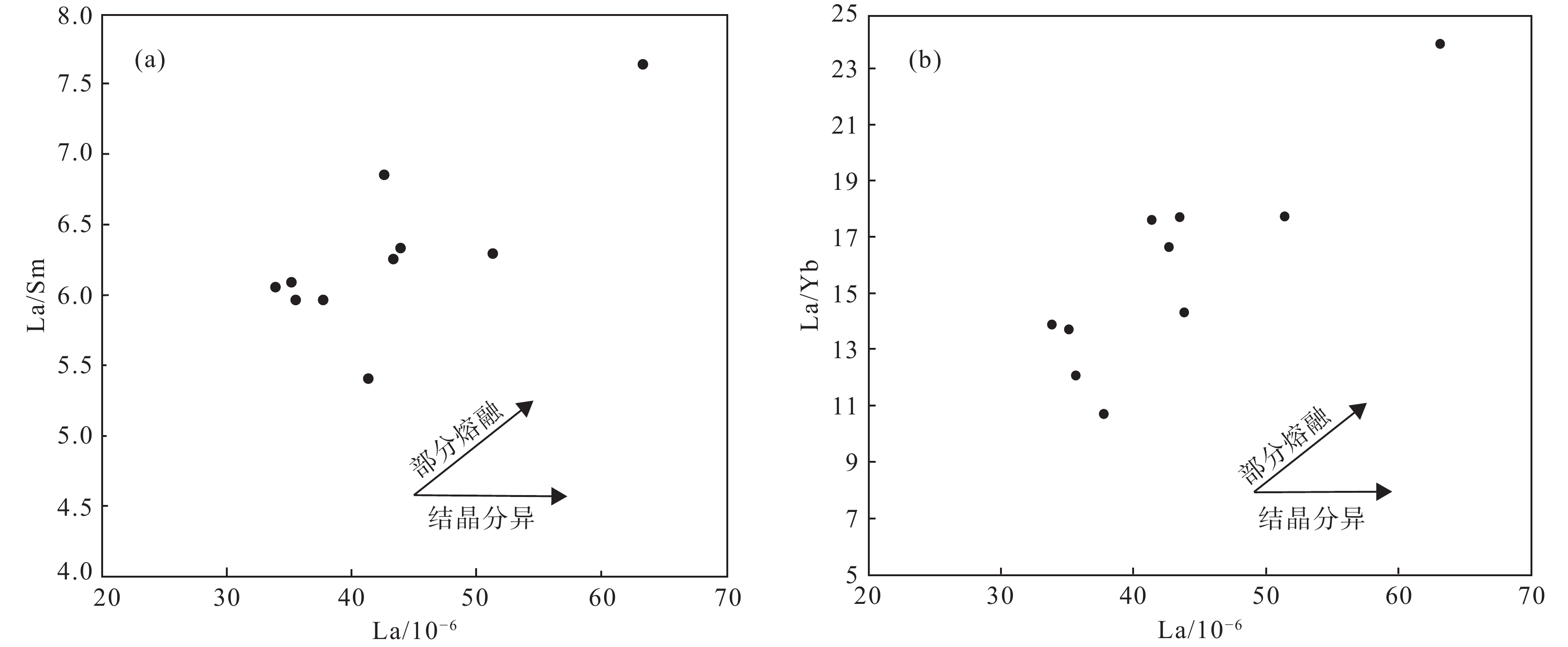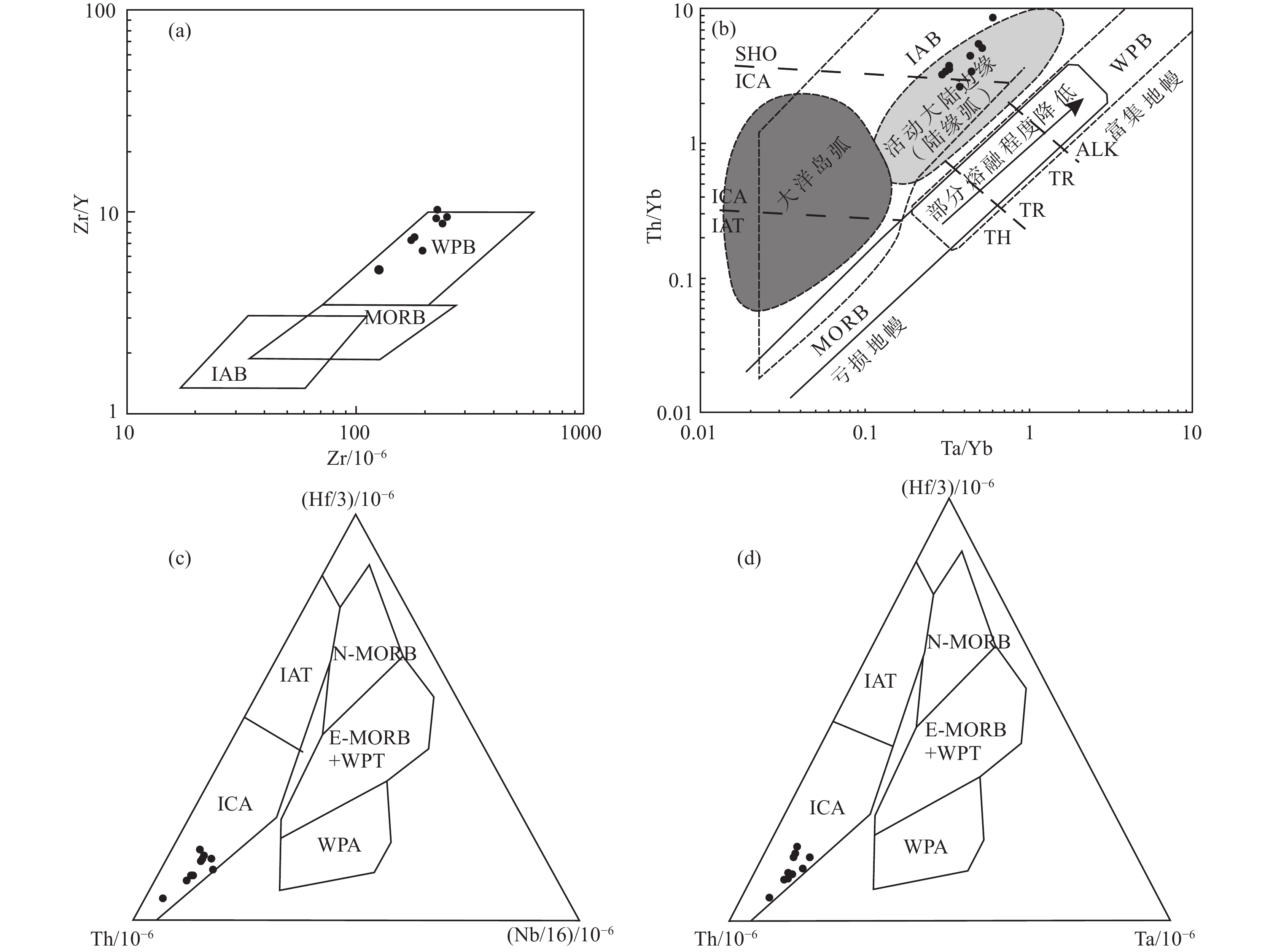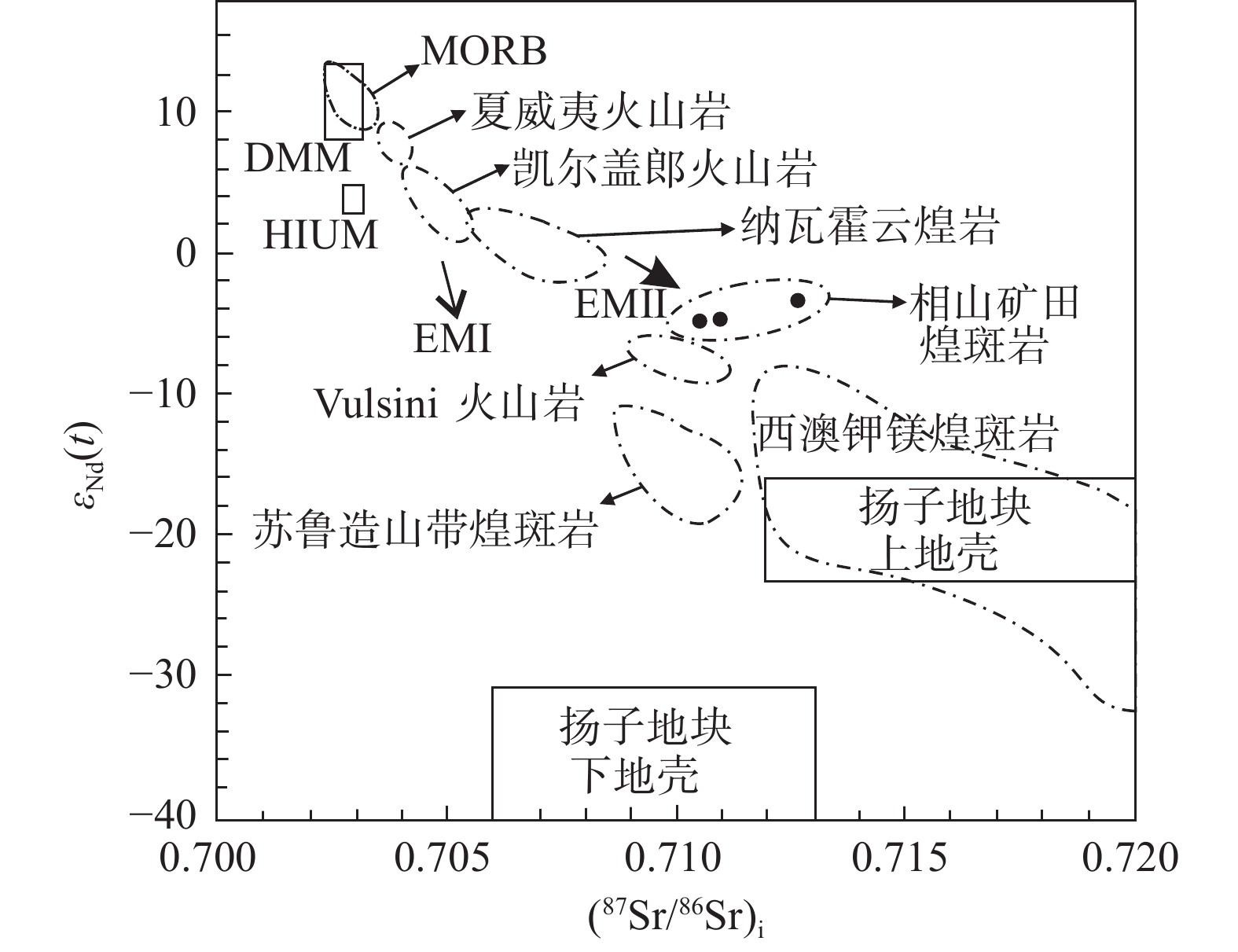Geochronology, geochemistry of lamprophyre and evidence of mantle fluid in the western part of Xiangshan uranium orefield
-
摘要:
研究目的 幔源岩浆是探讨深部动力学演化和铀成矿的研究对象,相山铀矿田基性岩脉是探讨区域岩浆演化和铀成矿的关键所在。
研究方法 本文对矿区西部煌斑岩脉进行了系统的岩石学、地质年代学和地球化学综合研究。
研究结果 本区存在3期煌斑岩,分别为134 Ma、120~125 Ma和84.5 Ma。该区煌斑岩为钠质碱性煌斑岩,富集LILE和LREE,亏损HFSE,具明显的Ta−Nb−Ti负异常,具有岛弧玄武岩和大陆地壳的微量元素特征。该区煌斑岩为部分熔融和结晶分异共同作用的产物,经历了橄榄石、单斜辉石的结晶分异作用,在岩浆上侵过程中受到明显上地壳物质的混染。该区煌斑岩形成于伸展作用下的板内拉张构造环境,未受到古太平洋板块俯冲作用的影响。其源区应为软流圈亏损地幔与岩石圈富集地幔的混合,且主要体现为软流圈亏损地幔特征。
结论 第一期煌斑岩矿岩时差大,仅为后期铀的沉淀富集提供有利条件;后两期煌斑岩矿岩时差小,不仅为相山矿田铀矿化提供了幔源流体(ΣCO2矿化剂和He),也为铀沉淀富集提供还原障。
Abstract:This paper is the result of mineral exploration engineering.
Objective Mantle−derived magma generally provied an object to reveal geodynamic evolution in the depth and uranium mineralization. The mafic dikes in the west of Xiangshan uranium deposit are regarded as a key aspect to understand the regional tectono−magmatic evolution and uranium mineralization.
Methods In this paper, the comprehensive research of petrology, geochronology and geochemistry were carried on the lamprophyre in the west of Xiangshan uranium deposit.
Results There are three stages of lamprophyre in this area, which are 134 Ma, 120–125 Ma and 84.5 Ma. The lamprophyre is sodium−alkaline lamprophyre and characterized with the enrichment of LILE and LREE, depletion of HFSE, and obvious negative anomaly of Ta–Nb–Ti. The lamprophyre is the product of partal melting from the source region and crystallisation differentiation, which experienced the crystallization differentiation of olivine and clinopyroxene as well as strong assimilation and contamination of upper crustal meterials during the magmatic intrusion. The lamprophyre was formed in the extentional entraplate tensioned tectonic environment, and was not affected by the subduction of the ancient Pacific Plate. The source region is a mixture of asthenospheric depleted mantle (main source) and lithospheric enriched mantle, which is mainly characterized by asthenospheric depleted mantle.
Conclusions The first period of lamprophyres is much older than the age of uranium mineralization, only providing favorable conditions for uranium accumulation. The later two periods of lamprophyres are closely associated with uranium deposits on space and time, possibly providing mantle hydrothemal fluids (∑CO2 and He) and a favorable reducing environment for uranium enrichment and deposition.
-

-
图 1 相山火山−侵入杂岩地质略图(据张万良, 2015)
Figure 1.
图 3 相山矿田煌斑岩SiO2–(Na2O+K2O)图(a,据Rock, 1987)和K/(K+Na)–K/Al(b,据路凤香等, 1991)
Figure 3.
图 4 煌斑岩原始地幔标准化微量元素蛛网图(a,标准化数据值据Sun and McDonough, 1989)和球粒陨石标准化REE配分模式图(b,标准化数据值据Boynton, 1984)
Figure 4.
图 5 相山矿田煌斑岩同化混染判别图解207Pb/204Pb–206Pb/204Pb图解(a)和208Pb/204Pb–206Pb/204Pb图解(b)(据Zartman and Doe, 1981)
Figure 5.
表 1 煌斑岩取样位置
Table 1. Sampling locations of larmprophyre
序号 样品编号 样品位置 孔号 孔深/m 1 ZK1−2−301 ZK56-102 477.50~478.30 2 ZK1−2−303 479.05~479.80 3 ZK1−2−301 ZK52-23 483.85~484.75 4 ZK1−2−303 485.70~486.65 5 ZK1−2−307 287.25~288.15 6 ZK1−2−311 291.00~291.90 7 ZK1−2−301 ZK56-101 298.00~298.30 8 ZK1−2−303 298.60~299.00 9 ZK1−2−301 ZK84-102 448.20~448.40 10 ZK1−2−303 448.60~448.80 表 2 相山矿田煌斑岩全岩K−Ar稀释法年龄测试结果
Table 2. Results of whole−rock K−Ar ages of lamprophyres with the dilutional method in Xiangshan orefield
序号 样品编号 岩性 40K/10−2 40Ar/10−6 40Ar/40K 空氩/10−2 年龄/Ma 活动期次 1 ZK1−2−303 煌斑岩 2.310 0.013860 0.005028 13.0 84.5 第三期 2 ZK1−2−303 煌斑岩 1.120 0.009601 0.007185 13.7 120 第二期 3 ZK1−2−303 煌斑岩 2.053 0.018350 0.007490 6.00 125 4 ZK1−2−303 煌斑岩 2.247 0.021570 0.008047 11.2 134 第一期 表 3 相山矿田煌斑岩主量元素(%)、微量(10−6)元素测试结果
Table 3. Analytical results of major element (%) and trace element (10−6) of lamprohyres in Xiangshan orefield
ZK1−2−301 ZK1−2−303 ZK1−2−301 ZK1−2−303 ZK1−2−307 ZK1−2−311 ZK1−2−301 ZK1−2−303 ZK1−2−301 ZK1−2−303 SiO2 51.00 44.90 44.30 42.40 42.20 53.12 47.90 54.40 51.10 49.30 TiO2 1.22 1.36 1.36 1.34 1.24 0.91 1.48 1.08 1.01 1.00 Al2O3 14.70 13.40 12.30 12.20 12.10 20.27 14.70 12.50 13.52 11.70 Fe2O3 6.95 5.80 4.25 4.85 4.90 6.00 5.20 5.25 6.45 4.50 FeO 10.40 8.81 10.40 11.60 10.00 8.79 9.23 9.15 9.03 7.13 MnO 0.12 0.17 0.19 0.19 0.24 0.19 0.18 0.14 0.13 0.18 MgO 7.22 7.50 11.20 13.60 12.60 3.50 6.35 5.66 6.89 4.85 CaO 3.82 9.51 7.14 7.64 9.05 1.09 6.68 5.27 5.48 10.20 Na2O 1.24 2.08 2.44 1.78 1.58 0.16 3.94 1.70 2.16 1.72 K2O 3.22 1.83 1.96 1.60 1.21 5.56 1.60 2.39 1.99 2.92 P2O5 0.27 0.30 0.54 0.50 0.49 0.19 0.29 0.23 0.28 0.22 LOI 6.73 9.96 7.96 7.35 9.34 3.22 7.29 7.27 2.85 10.27 Cr 256 411 341 354 359 95.40 283 179 26.30 245 Ni 128 149 172 193 166 38.20 116 93.30 11.60 96.60 Rb 154 148 124 104 39.3 125 93.10 105 145 132 Ba 603 60.70 527 706 1083 605 138 303 234 568 Th 15.30 8.53 9.76 8.68 8.62 9.34 9.18 13.70 22.40 10.70 U 5.620 5.400 2.730 1.990 2.160 2.750 9.460 3.440 7.410 3.260 Nb 22.20 21.10 16.70 13.90 14.50 12.40 19.70 18.40 15.60 16.70 Ta 1.620 1.160 0.920 0.770 0.810 0.870 1.350 1.290 1.600 1.090 Sr 142 299 480 598 744 91.50 145 174 73.40 258 Zr 239 175 252 226 226 251 197 183 127 177 Hf 6.390 4.230 5.800 5.120 5.420 6.430 5.560 4.920 4.130 4.410 Tl 1.010 0.710 0.810 0.590 0.350 0.100 0.720 0.580 0.830 0.840 Y 27.00 23.20 26.50 23.90 22.00 26.60 30.30 24.10 24.40 23.90 Li 229 165 148 154 169 82.60 154 234 64.9 145 Be 4.580 3.510 2.380 2.160 1.410 2.130 4.880 4.360 2.500 3.910 Sc 22.90 25.50 26.80 29.60 27.40 14.00 24.00 18.40 5.910 21.30 V 141 162 197 193 188 106 164 120 30.00 126 Co 34.80 33.70 42.50 46.30 37.30 16.80 34.70 28.40 5.110 27.00 Cu 72.30 37.60 50.10 46.80 38.10 65.90 95.00 59.60 12.20 62.50 Zn 104 90.0 90.20 86.60 86.40 102 86.50 87.60 43.00 68.70 Ga 19.80 21.20 16.30 17.50 15.90 17.30 25.20 16.70 17.10 14.80 Mo 1.780 1.020 0.235 0.156 0.499 0.419 2.850 2.470 2.800 1.030 Cd 0.080 0.130 0.100 0.130 0.120 0.050 0.090 0.080 0.070 0.140 In 0.080 0.060 0.060 0.050 0.060 0.050 0.060 0.050 0.060 0.050 Sb 0.400 0.690 0.190 0.170 0.480 0.300 1.270 0.610 0.510 0.830 Cs 9.530 36.70 27.50 33.20 31.10 15.00 7.190 9.490 14.00 9.040 W 6.270 4.130 2.530 1.620 0.970 2.230 6.100 4.980 4.660 4.470 Re 0.004 0.001 0.002 0.002 — 0.001 0.001 0.004 0.004 0.002 Pb 7.990 13.60 8.290 7.940 9.700 7.920 15.80 15.90 18.20 19.60 Bi 0.280 0.150 0.080 0.080 0.040 0.150 0.250 0.310 0.500 0.150 La 43.90 35.10 51.40 41.30 43.50 35.60 37.80 42.70 63.30 33.90 Ce 83.90 67.10 92.20 80.00 80.60 66.80 72.10 77.80 114.0 64.80 Pr 10.30 8.240 11.40 10.30 10.10 8.060 8.830 9.490 13.30 7.680 Nd 39.60 32.50 46.30 42.40 39.40 32.20 34.30 35.80 48.80 29.90 Sm 6.960 5.780 8.180 7.660 6.980 5.980 6.360 6.250 8.300 5.600 Eu 1.390 1.560 2.490 2.220 2.250 1.470 1.750 1.310 0.900 1.310 Gd 6.130 5.130 7.060 6.630 6.210 5.410 5.810 5.270 6.570 5.360 Tb 1.030 0.860 1.100 1.030 0.960 0.980 1.070 0.890 1.050 0.880 Dy 5.530 4.620 5.640 5.120 4.720 5.510 6.010 4.730 5.350 4.750 Er 3.180 2.540 2.860 2.550 2.530 2.920 3.590 2.640 2.690 2.520 Tm 0.490 0.390 0.440 0.380 0.360 0.480 0.540 0.400 0.440 0.400 Yb 3.070 2.560 2.900 2.340 2.460 2.950 3.530 2.570 2.650 2.440 Lu 0.630 0.610 0.630 0.540 0.620 0.600 0.590 0.680 0.760 0.610 REE 206.11 166.99 232.60 202.47 200.70 168.96 182.29 190.53 268.12 160.14 (La/Yb)N 9.64 9.24 11.95 11.90 11.92 8.14 7.22 11.20 16.10 9.37 (Gd/Yb)N 1.61 1.62 1.96 2.29 2.04 1.48 1.33 1.65 2.00 1.77 (La/Sm)N 3.97 3.82 3.95 3.39 3.92 3.74 3.74 4.30 4.80 3.81 δEu 0.65 0.88 1.00 0.95 1.04 0.79 0.88 0.70 0.37 0.73 δCe 0.95 0.95 0.92 0.93 0.93 0.95 0.95 0.93 0.95 0.97 表 4 相山矿田煌斑岩Sr–Nd–Pb同位素组成
Table 4. Sr–Nd–Pb isotopic composition of lamprophyres in the Xiangshan orefield
ZK1−2−303 ZK1−2−303 ZK1−2−303 147Sm/144Nd 0.1075 0.1055 0.1232 143Nd/144Nd 0.5124 0.5123 0.5123 (143Nd/144Nd)i 0.5123 0.5122 0.5123 87Rb/86Sr 1.4333 1.7474 1.4815 87Sr/86Sr 0.7155 0.7144 0.7135 (87Sr/86Sr)i 0.7128 0.7113 0.7117 208Pb/204Pb 38.8060 38.8940 38.7810 207Pb/204Pb 15.6270 15.6180 15.8150 206Pb/204Pb 18.8270 18.6120 18.6270 (208Pb/204Pb)i 38.5190 38.5400 38.6300 (207Pb/204Pb)i 15.6010 15.6050 15.6050 (206Pb/204Pb)i 18.2920 18.3410 18.5320 εNd(t) −3.25 −4.76 −5.37 注:样品87Rb/86Sr比值根据微量元素含量(表2)和87Sr/86Sr测量值计算得到;样品147Sm/144Nd比值根据微量元素含量(表2)和143Nd/144Nd测量值计算得到。 表 5 相山矿田煌斑岩同化混染微量元素比值
Table 5. Ratios of trace elements of lamprophyres assimilation and contamination in the Xiangshan orefield
相山矿田 同化混染 未同化混染 备注 Yi/Yb 1849~3488 <5000 >5000 Hart et al., 1989 Ba/Nb 15.00~74.69 >10 <10 Furman et al., 2006 La/Nb 1.92~4.06 >1 <1 (Th/Nb)N 3.39~12.05 >1 <1 夏林圻等, 2007 Nb/La 0.24~0.60 <1 ≥1 夏林圻等, 2007 表 6 相山矿田煌斑岩构造环境判别
Table 6. Environmental discrimination of lamprophyres in Xiangshan orefield
相山矿田煌斑岩 大陆玄武岩 岛弧玄武岩 未受到大陆岩石圈混染 受大陆岩石圈混染 具古老基底 较年轻岛弧
增生地体不相容微量元素浓度 高于消减带玄武岩 高于消减带玄武岩 等同于消减带玄武岩 Nb、Ta、Ti Nb–Ta–Ti负异常 “隆起状”似OIB不相容元素配分模式 Nb–Ta–Ti负异常 Nb–Ta–Ti负异常 Nb/La 0.25~0.60 ≥1 <1 <1 εNd(t) −3.25 ~ −5.37 中等正值 低负值 高正值 高正值 87Sr/86Sr(t) 0.713485~0.714443 低—中等 中等—高 低 低 各种地球化学
判别图中位置在不利用Nb–Ta–Ti作为判别因子的图解中,仍具WPB的特性 恒定于WPB成分域中 在不利用Nb–Ta–Ti作为判别因子的图解中,仍然具有WPB的特性 恒定于弧玄武岩成分域中 -
[1] Alibert C, Michard A, Albaréde F. 1986. Isotope and trace element geochemistry of Colorado Plateau volcanics[J]. Geochimica et Cosmochimica Acta, 50(12): 2735−2750. doi: 10.1016/0016-7037(86)90223-1
[2] Boynton W V. 1984. Cosmochemistry of the rare earth elements: Meteorite studies[J]. Developments in Geochemistry, 2: 63−114.
[3] Chen W F, Chen P R, Xu X S, Zhang M. 2005. Geochemical characteristics of Cretaceous basaltic rocks in South China and constraints on Pacific plate subduction[J]. Science in China (Series D: Earth Sciences), 48(12): 2104−2117. doi: 10.1360/04yd0149
[4] Deng Ping, Shen Weizou, Ling Hongfei, Ye Haimin, Wang Xuecheng, Pu Wei, Tan Zhengzhong. 2003. Uranium mineralization related to mantle fluid: A case study of the Xianshi deposit in the Xiazhuang uranium orefield[J]. Geochimica, 32(6): 520−528 (in Chinese with English abstract).
[5] Fan Honghai, Wang Dezi, Liu Changshi, Zhao Lianze, Shen Weizhou, Ling Hongfei, Duan Yun. 2001. Discovery of quenched enclaves in subvolcanic rocks in Xiangshan, Jiangxi Province and its genetic mechanism[J]. Acta Geologica Sinica, 75(1): 64−69 (in Chinese with English abstract).
[6] Furman T, Kaleta K M, Bryce J G, Hanan B B. 2006. Tertiary mafic lavas of Turkana, Kenya: Constraints on East African plume structure and the occurrence of high–μ volcanism in Africa[J]. Journal of Petrology, 59(6): 2583−2591.
[7] Fraser K J, Hawkesworth C J, Erlank A J, Mitchell R H, Scott–Smith B H. 1985. Sr, Nd and Pb isotope and minor element geochemistry of lamproites and kimberlites[J]. Earth and Planetary Science Letters, 76(1): 57−70.
[8] Gao S, Ling W L, Qiu Y M, Lian Z, Hartmann G, Simon K. 1999. Contrasting geochemical and Sm–Nd isotopic compositions of Archean Metasediments from the Kongling high–grade terrain of the Yangtze craton: Evidence for cratonic evolution and redistribution of REE during crustal anatexis[J]. Geochimica et Cosmochimica Acta, 63(13/14): 2071−2088.
[9] Guo F, Fan W M, Wang Y J, Zhang M. 2004. Origin of early Cretaceous calc–alkaline lamprophyres from the Sulu orogen in Eastern China: Implications for enrichment processes beneath continental collisional belt[J]. Lithos, 78(3): 291−305. doi: 10.1016/j.lithos.2004.05.001
[10] Hart S R. 1988. Heterogeneous mantle domains: Signatures, genesis and mixing chronologies[J]. Earth and Planetary Science Letters, 90(3): 273−296. doi: 10.1016/0012-821X(88)90131-8
[11] Hart W K, Woldegabriel G, Walter R C, Mertzman S A. 1989. Basaltic volcanism in Ethiopia: Constraints on continental rifting and mantle interactions[J]. Journal of Geophysical Research: Solid Earth, 94(B6): 7731−7748. doi: 10.1029/JB094iB06p07731
[12] Hu Ruizhong, Bi Xianwu, Su Wenchao, Peng Jiantang, Li Chaoyang. 2004. The relationship between uranium metallogenesis and crustal extension during the Cretaceous–Tertiary in South China[J]. Earth Science Frontiers, 11(1): 153−160 (in Chinese with English abstract).
[13] Hu Ruizhong, Luo Jincheng, Chen Youwei, Pan Lichuan. 2019. Several progresses in the study of uranium deposits in South China[J]. Acta Petrologica Sinica, 35(9): 2625−2636 (in Chinese with English abstract). doi: 10.18654/1000-0569/2019.09.01
[14] Hu R Z, Burnard P G, Bi X W, Zhou M F, Peng J T, Su W C, Zhao J H. 2009. Mantle–derived gaseous components in ore–forming fluids of the Xiangshan uranium deposit, Jiangxi province, China: Evidence from He, Ar and C isotopes[J]. Chemical Geology, 266(1/2): 86−95.
[15] Lin Jinrong, Hu Zhihua, Wang Yongjian, Zhang Song, Tao Yi. 2019. Ore–forming age and thermal history of uranium–polymetallic mineralization in Xiangshan uranium orefield[J]. Acta Petrologica Sinica, 35(9): 2801−2816 (in Chinese with English abstract). doi: 10.18654/1000-0569/2019.09.12
[16] Lu Fengxiang, Shu Xiaoxin, Zhao Chonghe. 1991. A suggestion on classification of lamprophyres[J]. Geological Science and Technology Information, 10(Sup): 55−62 (in Chinese with English abstract).
[17] Luo Jincheng, Qi Youqiang, Wang Lianxun, Chen Youwei, Tian Jianji, Shi Shaohua. 2019. Ar–Ar dating of mafic dykes from the Xiazhuang uranium ore field in northern Guangdong, South China: A reevaluation of the role of mafic dyke in uranium mineralization[J]. Acta Petrologica Sinica, 35(9): 2660−2678 (in Chinese with English abstract). doi: 10.18654/1000-0569/2019.09.03
[18] Ma L, Jiang S Y, Hofmann A W, Dai B Z, Hou M L, Zhao K D, Chen L H, Li J W, Jiang Y H. 2014. Lithospheric and asthenospheric sources of lamprophyres in the Jiaodong Peninsula: A consequence of rapid lithospheric thinning beneath the North China Craton?[J]. Geochimica et Cosmochimica Acta, 124: 250−271. doi: 10.1016/j.gca.2013.09.035
[19] Ormerod D S, Hawkesworth C J, Rogers N W, Leeman W P, Menzies M A. 1988. Tectonic and magmatic transitions in the Western Great Basin USA[J]. Nature, 333(26): 349−353.
[20] Pearce J A. 1982. Trace Element Characteristics of Lavas from Destructive Plate Boundaries[M]. Andesites: Orogenic Andesites and Related Rocks, 525–548.
[21] Rock N M S. 1987. The nature and origin of lamprophyre: An overview[J]. Alkaline Igneous Rocks, 30(1): 191−226.
[22] Roger N W, Hawkesworth C J, Parker R J, Marsh J S. 1985. The geochemistry of potassic lavas from Vulsini, Central Italy and implications for mantle enrichment processes beneath the Roman Region[J]. Contributions to Mineralogy and Petrology, 90(2/3): 244−257.
[23] Sun S S, McDonough W F. 1989. Chemical and isotopic systematics of oceanic basalts: Implications for mantle composition and processes[J]. Geological Society, London, Special Publications, 42(1): 313–345.
[24] Taylor S R, McLennan S M. 1985. The Continental Crust: Its Composition and Evolution[M]. Oxford: Blackwell Scientific Publications, 1–312.
[25] Wang Yongjian. 2015. Characteristics of Granite–porphyry and Meso–Mafic Dykes in Xiangshan and Their Relationship with Uranium Mineralization[D]. Beijing: Institute of Nuclear Industry (Beijing), 1–112 (in Chinese).
[26] White W M, Hofmann A W. 1982. Sr and Nd isotope geochemistry of oceanic basalts and mantle evolution[J]. Nature, 296(5860): 821−825. doi: 10.1038/296821a0
[27] Wu Hao, Xu Zuyang, Yan Weibing, Hao Yujie, Liu Haiyong. 2023. Zircon U–Pb ages and geochemical characteristics of diabase in Nie’erco area, entral Xizang: Implication for Neo–Tethyan slab breakoff[J]. Geology in China, 50(6): 1804−1816 (in Chinese with English abstract).
[28] Wu Jianhua, Lao Yujun, Xie Guofa, Zhang Jingyan, Wu Rengui, Nie Fengjun. 2017. Stratigraphy and geochronology of the volcanic rocks in the Xiangshan uranium orefield, Jiangxi Province and its geological implications[J]. Geology in China, 44(5): 974−992 (in Chinese with English abstract).
[29] Wood D A. 1980. The application of a Th–Hf–Ta diagram to problems of tectonomagmatic classification and to establishing the nature of crustal contamination of basaltic lavas of the British Tertiary volcanic province[J]. Earth and Planetary Science Letters, 50(1): 11−30. doi: 10.1016/0012-821X(80)90116-8
[30] Xia Linqi, Xia Zhuchun, Xu Xueyi, Li Xiangmin, Ma Zhongping. 2007. The discrimination between continental basalt and island arc basalt based on geochemical method[J]. Acta Petrologica et Mineralogica, 26(1): 77−89 (in Chinese with English abstract).
[31] Yang Qingkun. 2015. Genesis of the Volcanic–intrusive Complex and Metallogenesis of Uranium Polymetallic in the Xiangshan Orefield of Jiangxi Province[D]. Beijing: China University of Geosciences (Beijing), 1–192 (in Chinese with English abstract).
[32] Yu Xinqi, Wu Ganguo, Shu Liangshu, Yan Tiezeng, Zhang Da, Di Yongjun. 2006. The Cretaceous tectonism of the Gan–Hang tectonic belt, southeastern China[J]. Earth Science Frontiers, 13(3): 31−43 (in Chinese with English abstract).
[33] Zartman R E, Doe B R. 1981. Plumbotectonics–the model[J]. Tectonophysics, 75: 135−162. doi: 10.1016/0040-1951(81)90213-4
[34] Zeng Wenle, Chen Rongqing, Xie Guofa, Pang Wenjing, Wu Zanhua. 2019. Prospecting progress and prospective analysis of uranium deposit in Xiangshan ore field[J]. Journal of East China University of Technology (Natural Science), 42(2): 101−107 (in Chinese with English abstract).
[35] Zhang Wanliang. 2015. Orebody morphology and mineralization structure type of Xiangshan uranium field[J]. Geotectonica et Metallogenia, 39(5): 844−854 (in Chinese with English abstract).
[36] Zindler A, Hart S. 1986. Chemical geodynamics[J]. Annual Review of Earth and Planetary Sciences, 14(1): 493−571. doi: 10.1146/annurev.ea.14.050186.002425
[37] 邓平, 沈渭洲, 凌洪飞, 叶海敏, 王学成, 濮巍, 谭正中. 2003. 地幔流体与铀成矿作用: 以下庄矿田仙山铀矿床为例[J]. 地球化学, 32(6): 520−528. doi: 10.3321/j.issn:0379-1726.2003.06.002
[38] 范洪海, 王德滋, 刘昌实, 赵连泽, 沈渭洲, 凌洪飞, 段芸. 2001. 江西相山潜火山岩中淬冷包体的发现及其成因机制探讨[J]. 地质学报, 75(1): 64−69. doi: 10.3321/j.issn:0001-5717.2001.01.007
[39] 胡瑞忠, 毕献武, 苏文超, 彭建堂, 李朝阳. 2004. 华南白垩—第三纪地壳拉张与铀成矿的关系[J]. 地学前缘, 11(1): 153−160. doi: 10.3321/j.issn:1005-2321.2004.01.012
[40] 胡瑞忠, 骆金诚, 陈佑纬, 潘力川. 2019. 华南铀矿床研究若干进展[J]. 岩石学报, 35(9): 2625−2636. doi: 10.18654/1000-0569/2019.09.01
[41] 林锦荣, 胡志华, 王勇剑, 张松, 陶意. 2019. 相山铀矿田多金属成矿时代与成矿热历史[J]. 岩石学报, 35(9): 2801−2816.
[42] 路凤香, 舒小辛, 赵崇贺. 1991. 有关煌斑岩分类的建议[J]. 地质科技情报, 10(增刊): 55−62.
[43] 骆金诚, 齐有强, 王连训, 陈佑纬, 田建吉, 石少华. 2019. 粤北下庄铀矿田基性岩脉Ar–Ar定年及其与铀成矿关系新认识[J]. 岩石学报, 35(9): 2660−2678. doi: 10.18654/1000-0569/2019.09.03
[44] 王勇剑. 2015. 相山花岗斑岩和中基性脉岩特征及其与铀成矿关系[D]. 北京: 核工业北京地质研究院, 1–112.
[45] 吴浩, 徐祖阳, 严维兵, 郝宇杰, 刘海永. 2023. 西藏中部聂耳错地区辉绿岩锆石U–Pb年龄与地球化学特征: 对新特提斯洋板片断离的指示[J]. 中国地质, 50(6): 1804−1816.
[46] 巫建华, 劳玉军, 谢国发, 张婧妍, 吴仁贵, 聂逢君. 2017. 江西相山铀矿田火山岩系地层学、年代学特征及地质意义[J]. 中国地质, 44(5): 974−992. doi: 10.12029/gc20170510
[47] 夏林圻, 夏祖春, 徐学义, 李向民, 马中平. 2007. 利用地球化学方法判别大陆玄武岩和岛弧玄武岩[J]. 岩石矿物学杂志, 26(1): 77−89. doi: 10.3969/j.issn.1000-6524.2007.01.011
[48] 杨庆坤. 2015. 江西相山矿田火山–侵入杂岩成因及其铀多金属的关系[D]. 北京: 中国地质大学(北京), 1–192.
[49] 余心起, 吴凎国, 舒良树, 颜铁增, 张达, 狄永军. 2006. 白垩纪时期赣杭构造带的伸展作用[J]. 地学前缘, 13(3): 31−43.
[50] 曾文乐, 陈荣清, 谢国发, 庞文静, 吴赞华. 2019. 相山矿田铀矿找矿进展及远景分析[J]. 东华理工大学学报(自然科学版), 42(2): 101−107.
[51] 张万良. 2015. 相山铀矿田矿体形态分类及成因意义[J]. 大地构造与成矿学, 39(5): 844−854.
-



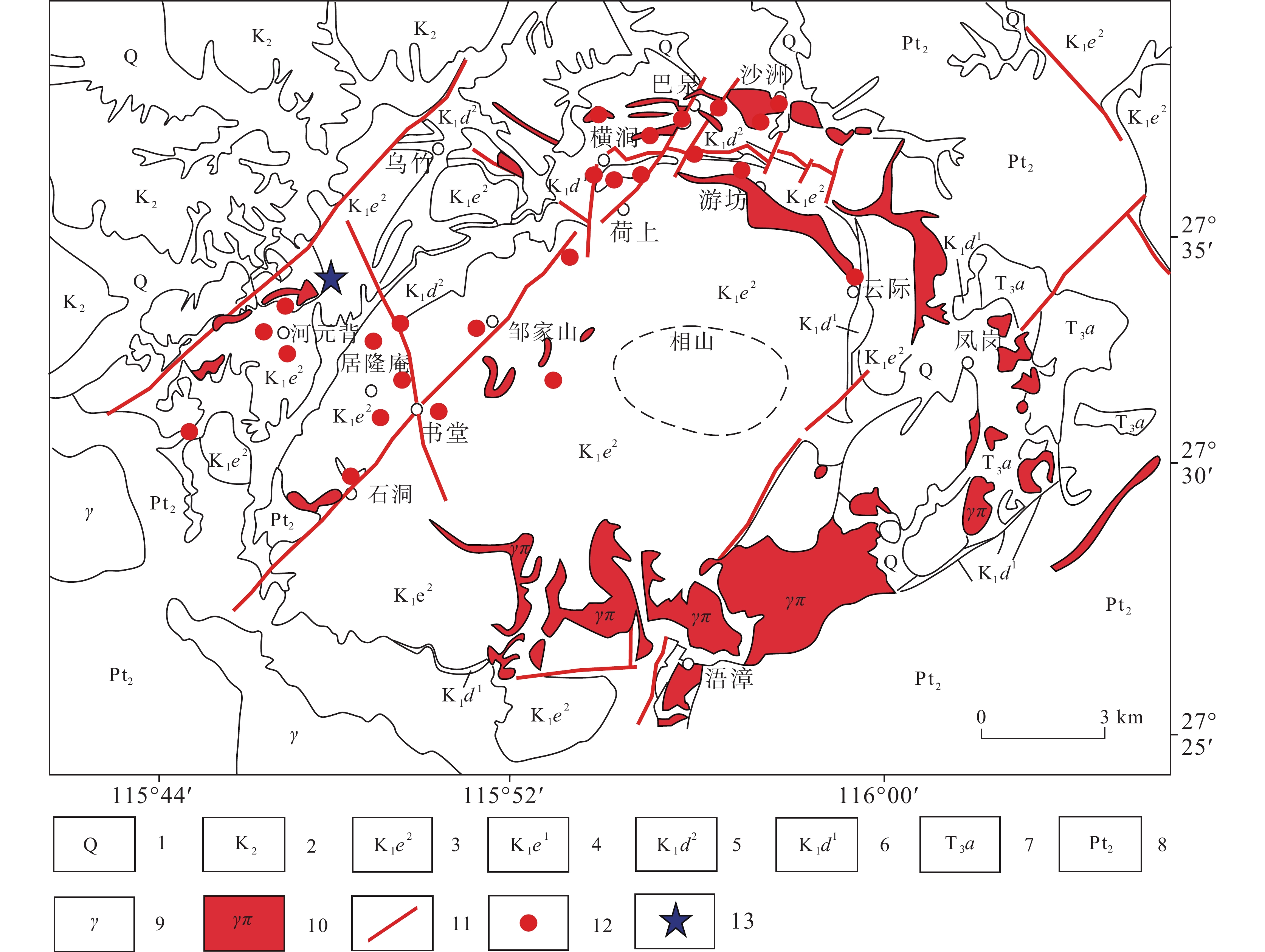
 下载:
下载:
